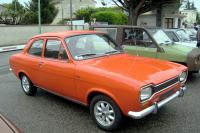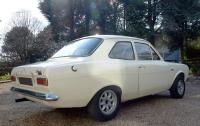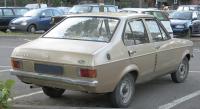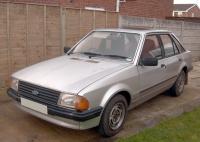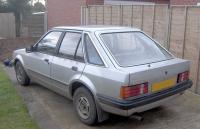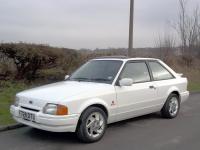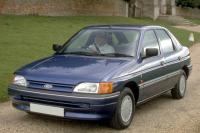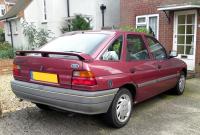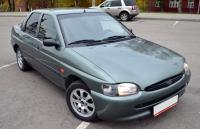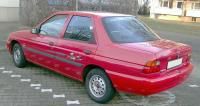First generation
The Escort of this generation was first introduced in the UK at the end of 1967 as a replacement for the long and successful Ford Anglia. The production of right-hand drive cars began in the last months of 1967, and left-hand drive cars in September 1968. This modification was produced with 1968 to 1975 year. During this time, more than 1 million cars were sold.
The first escort had rear-wheel drive, 4-speed manual or 3-speed automatic transmission. The front suspension was of the MacPherson type, and the rear axle was mounted on leaf springs. Initially, it was a two-door sedan, and at the end of March 1968, a two-door station wagon appeared. In 1969, a 4-door sedan appeared, as well as a 2-door van.
The engine was installed type Kent Crossflow with a volume of 1.1 and 1.3 liters. Also, a 940 cc engine was installed on a small number of cars. There were no diesel engines on the first Escort.
The Escort I was very successful in rally racing. In the late 60s and early 70s, the Ford team was almost unbeatable.
Second generation
The first production models of the second generation Escort rolled off the assembly line on December 2, 1974, and went on sale in January 1975. Most notable was the change from round shapes to rectangular ones that were fashionable at the time. This modification was made with 1975 to 1980 year. During this time, more than 2 million cars have been sold. Production ended in 1980 in the UK and shortly thereafter in other countries.
The body was made in modifications - a sedan and station wagon for 4, both with two and four doors, as well as a two-door van. The engines were the same as in the first generation - 1.1L (45 HP) and 1.3L (70 HP). The suspension hasn't changed either.
This generation also shone in rally racing. From 1975 to 1979 the Escort II won the RAC Rally and other races around the world.
Third generation
In September 1980, the Escort III was launched under the code name Erika. The most important difference from previous generations is the front-wheel drive and transverse engine layout, as well as a new modern design. Production was from 1980 to 1986 year.
A new body type has appeared - a hatchback with three or five doors. In 1983, they began to produce a sedan and a convertible. The sedan version of the Escort became known as the Orion. This name lasted until 1993. Previously, the station wagon was available only with three doors, and in 1983 they began to produce a 5-door station wagon.
The range of gasoline engines has expanded - 1.1, 1.3 and 1.6 liters. The first modification with a 1.6-liter diesel engine appeared (54 HP). The transmission was available in three versions - 4 and 5-speed manual or 3-speed automatic. The suspension has become completely independent, leaving archaic springs in the past. Power steering was available on US versions.
The Escort was chosen Car of the Year in 1981 in Europe, beating its competitors at the time, Fiat Panda and Austin Metro.
Fourth generation
This generation of Escorts mostly had cosmetic upgrades. Changes mostly affected the hood, bumpers and interior. Production lasted from 1986 to 1990 year.
The engines were of two types - gasoline with a volume of 1.1, 1.3, 1.4 and 1.6 liters and diesel with a volume of 1.6 (54 HP), 1.7 (60 HP) and 1.8 (60 HP). In 1987, a catalytic converter was introduced. The transmission was the same as the third generation.
Fifth generation
A completely redesigned body for this generation was introduced in September 1989. Production continued from 1990 to 2000 year.
Later, in 1992, the engines also underwent modernization and their choice increased. 1.3, 1.4, 1.6, 1.8 and 2.0 liter petrol engines and 1.8 turbo diesel (60 HP and 90 hp). Transmission 4 and 5-speed manual or 3-speed automatic.
The Escort became available with options that have become common today, such as power steering, power windows, central locking, electronic ABS and air conditioning.
Also in 1992, the model was facelifted. The hood, grille, and hatchbacks have been changed. In 1993, the Orion name for sedans was dropped and changed back to Escort. All modifications began to be equipped with 16-valve Zetec engines with a volume of 1.6 or 1.8 liters. For impact during an accident, the body structure was improved, later airbags appeared.
Sixth generation
The latest generation Escort is based on the previous model, but has undergone a major upgrade. Production continued from 1995 to 2000 year.
There are new headlights, front fenders, hood, both bumpers, rear-view mirrors, door handles and 4 grille options. The interior has also been heavily modified with a new dashboard, seats, upholstery and a roomy trunk.
The suspension and bodywork have also changed a lot. They changed the angle of inclination of the front struts, installed springs, changed the rear suspension struts and the rear beam, new amplifiers and spars, front and rear cups, amplifiers in the doors. This increased the rigidity of the body and the handling of the car.
There are two types of transmission - 5-speed manual or 3-speed automatic. The engines were both petrol and diesel.
Petrol
- 1.3 8V 44KW (60 HP)
- 1.4 8V 55KW (75 HP)
- 1.6 16V 65KW (88 HP)
- 1.6 16V 66KW (90 HP)
- 1.8 16V 75KW (105 HP)
- 1.8 16V 85KW (115 HP)
- 1.8 16V 96KW (130 HP)
- 2.0 16V 110KW (150 HP) - RS2000
- 2.0 16V 162KW (220 HP) - RS Cosworth
Diesel
- 1.8 D 44 kW (60 HP)
- 1.8 TD 51 kW (70 HP)
- 1.8 TD 66 kW (90 HP)
In 1998, the demand for Escort began to fall, as a new model appeared - Ford Focus. From that time until 2000, various modifications were gradually discontinued, and in September 2000, the last Escort in Europe rolled off the assembly line of the plant.
